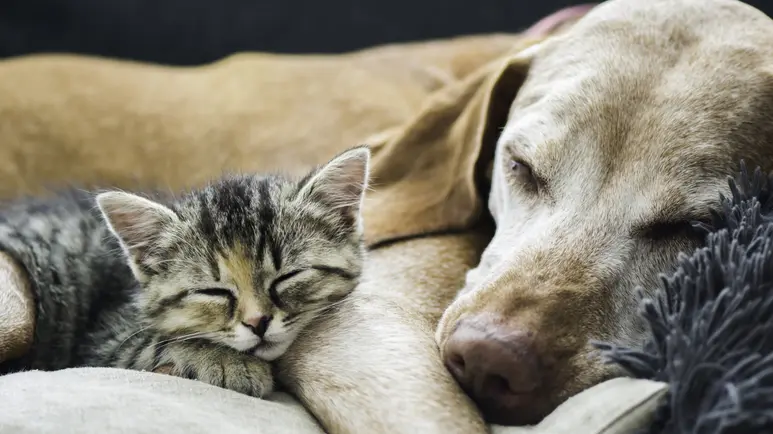A Top Reason for Euthanasia — How to Help Avoid It
It's a leading cause behind why owners put their senior pets down, but it's often one that's avoidable if you take the proper actions. Here's how to help your pet live a long, active life — one that doesn't need to end before it's time.

STORY AT-A-GLANCE
- Loss of mobility is a leading cause of euthanasia among senior pets, and it’s often one that’s avoidable if you take the proper precautions
- Encourage your dog and your cat to engage in movements that will benefit muscle strength, joint flexibility and overall health
- Mental exercise, such as obstacle courses and nose work, keep your pet involved in the activity and may improve neurologic and muscle control
- Lack of mobility due to medical conditions like arthritis and intervertebral disc disease (IVDD) require a comprehensive treatment plan for best results
- If your pet is overweight or obese, the extra weight adds stress to joints and muscles, which may contribute to mobility problems
Editor's Note: This article is a reprint. It was originally published June 24, 2016.
Regular physical activity is incredibly important for your pets, and this is particularly true as your pet ages. Loss of mobility is a leading cause of euthanasia among senior pets, and it's often one that's avoidable if you take the proper precautions.
Quite simply, by keeping your pet moving you can help her to live a long, active life. Even senior pets that have limited mobility may be able to improve significantly using the steps that follow.
10 Tips to Improve Mobility in Your Senior Pet
Rehabilitation specialist Dr. Kara Amstutz compiled the tips that follow for DVM 360.1 If you've noticed that your pet isn't moving around as much as she used to, or has difficulty performing activities she used to enjoy or complete with no problem, see your veterinarian and get started using these tips sooner rather than later.
- Have your pet checked by your veterinarian — Before starting your pet on an exercise program, be sure it's safe for her to do so. Medical conditions such as arthritis, heart conditions or respiratory problems may require a specialized exercise program.
- Help your pet lose weight — If your pet is overweight or obese, the extra weight adds stress to joints and muscles, which may contribute to mobility problems.
In one study of 14 overweight dogs with hip dysplasia and arthritis, losing less than 9% of their initial body weight led to significant improvements in walking and trotting.2 - Start with five-minute walks — Once your pet can comfortably walk for five minutes, add another minute or two each day until she can walk for 30 minutes at a time.
- Watch for signs of pain — If your pet limps, lags behind you or refuses to walk, she may be in pain. See an integrative veterinarian to figure out the cause of the pain as well as natural options for pain relief.
- Increase intensity — Once your pet is used to walking, add in activity that increases the duration, speed and intensity of your pet's daily exercise. For example, you may go for a walk on sand or up and down hills.
- Strengthen hind limbs — Many pets lose strength in their hind limbs, which makes it difficult to climb stairs or jump onto the couch. Specific exercises aimed at the hind limbs can help (see below for an example).
- Stimulate your pet's mind — Mental exercise, such as obstacle courses and nose work, keep your pet involved in the activity and may improve neurologic and muscle control.
- Keep it interesting — You can change up your pet's daily routine using household items. For instance, have your dog walk or jump over a garden hose you've arranged in your yard or create an obstacle course using broom handles and ladders.
- Keep trying — Even if your pet displays a lack of strength and flexibility, an exercise program can be tailored to fit her needs. Keep working with your pet to improve her mobility — don't give up.
- Consider rehabilitation — Canine rehabilitation therapy can be used to improve your pet's motor skills, reduce pain, build strength and increase range of motion.
This may be particularly helpful if your pet has lost mobility due to postoperative cranial cruciate ligament (CCL) damage, postoperative femoral head and neck ostectomy, spinal cord diseases, osteoarthritis or obesity.
Simple Strength-Building Exercises for Dogs and Cats
You can encourage your dog and, yes, your cat to engage in movements that will benefit muscle strength, joint flexibility and overall health. These are especially important for senior pets, although you may use them for younger pets as well. Amstutz recommends:3
- Step-ups — Have your dog put both front feet up on one step, which shifts her weight to her hind legs. Hold the position for 60 seconds. You can also have your pet move her front legs up to the next step for added intensity (if she's large enough to reach it).
- Three-legged stands — While your pet is standing, pick up one of her paws, which will cause her to shift her weight onto the other three paws. This helps to build strength and balance. Hold the position for 10 to 20 seconds and repeat with each limb.
- Sit to stands — Have your dog sit and then have him stand. Repeat the repetition 10 to 15 times. Do this twice a day (and give your pet plenty of rewards to keep him interested).
It can be slightly more challenging to convince your cat to exercise, but it can be done. Try to engage your cat in play using a variety of novel toys.
You can also place small amounts of food in various dishes around your home (including some in elevated locations) so your cat has to move around to get them. You can also toss a treat to another part of the room so your cat must walk to get it.
Keeping Your Pet Mobile Requires a Comprehensive Plan
Regular activity and strength-building exercises are keys to helping your pet avoid mobility problems, but they're only one part of the larger picture. Your senior pet can continue to lead an active life even in old age, but you'll need to address any hurdles to his mobility.
For instance, arthritic pets may benefit from nutritional interventions that support cartilage repair and maintenance, including supplementation with perna mussel, cetyl myristoleate, eggshell membrane, glucosamine and chondroitin sulfate.
Adding natural anti-inflammatories is also beneficial, including omega-3 fatty acids (krill oil), turmeric and proteolytic enzymes.
Incorporating chiropractic care, massage, acupuncture, daily stretching, and mild exercise — like swimming — along with an oral protocol to manage pain and inflammation will yield the very best results for an arthritic pet.
In the case of canine degenerative myelopathy, or DM, a disease of the spinal cord, the plan is different. As the disease progresses, the limbs become weaker and the dog has difficulty standing. Ultimately, the dog becomes unable to walk. A key to maintaining a DM dog's quality of life and slowing the progression to immobility is maintaining rear limb muscle tone.
Regular exercise such as walking for as long as the dog is able, in addition to range of motion exercises and other forms of physical therapy can delay the muscle atrophy associated with DM and maintain mobility and muscle strength for as long as possible. The single best intervention with DM dogs is swim therapy as often as possible (every other day is optimal).
Intervertebral disc disease (IVDD) is another condition that can cause lack of mobility in pets. It's a condition in which a disc develops a problem and the material inside escapes into the spinal column, ultimately causing pain, nerve damage, and even paralysis.
The goals for treating IVDD patients are to eliminate pressure on the spinal cord and resolve inflammation in order to return the pet to a pain-free and fully mobile life. Treatment can involve medical management or surgical intervention, depending on the severity of the disease. Acupuncture (and electro-acupuncture) is an exceptionally beneficial modality for IVDD patients. So you can see that in order to fully address your pet's lack of mobility, addressing the underlying cause is crucial.
For pets that are older but otherwise healthy, a fresh, balanced, naturally anti-inflammatory, and species-appropriate diet and regular exercise will keep her body strong and flexible. You can find additional exercises to keep your senior pet strong and nimble here.











